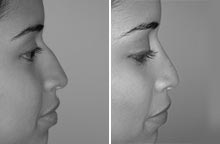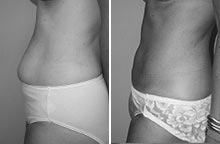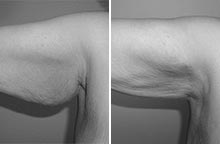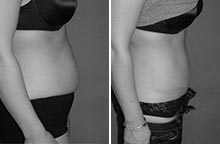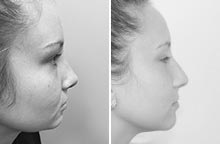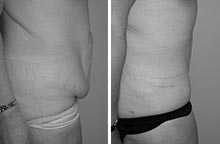Otoplasty
Consultations offered at our three convenient locations in New Jersey, Bergen County and Englewood, NJ
Contents
What is Ear Surgery?
Ear surgery, also known as Otoplasty, creates a natural-looking shape to your ears, bringing balance and proportion to your face.
Otoplasty or cosmetic correction of your ear deformities is a procedure usually performed during early adolescence, but can be performed on adults as well. Ear improvement or enhancement can be accomplished with both surgical and non-surgical approaches.
In older patients, Otoplasty can involve reducing the angle or protrusion of the ear. Some people mistake overly large ears for ears that are simply just pushed forward. By re-creating the fold, we can create a much more normal anatomic appearing ear, giving anyone an immediate confidence boost.
For both children and adults alike, overly large, protruding, or disfigured ears can be a source of emotional discomfort. Especially for children, the unfortunately inevitable schoolyard taunting and teasing can be detrimental to their self-confidence. With ear surgery, Dr. Abramson can correct these characteristics restoring self-esteem, or if resolved early on, avoiding it altogether.
Whether the appearance of your ears is due to a genetic trait or damage from an injury, Dr. David L. Abramson can help. He has offices in New York City, Franklin Lakes, and Englewood, NJ, making it convenient for ear surgery patients to achieve the look they truly desire.
Is Ear Surgery Right for You?
Both children and adults can undergo ear surgery. However, children should have ear cartilage that is stable enough for the procedure. All New York and New Jersey ear surgery patients should be in good health and have realistic expectations.
There are two common reasons for ear surgery. Some patients want to address overly large ears, which are typically caused by a rare condition called macrotia. Others are looking to correct ears that stick out in varying degrees, from one or both sides of their head.
Dr. Abramson prides himself on conducting a comprehensive evaluation during your initial visit. He makes sure that all his Otoplasty patients are getting the care and attention they need.
Ear Shapes
Stahl’s Ear Deformity
Similar to the point of an elf’s ear, Stahl’s Ear Deformity presents itself when the top portion of the rim of the ear has an extra part, thus creating a point.
Question Mark Ear
A deformity in the upper region of the ear that causes the shape to protrude outward, much like the shape of a question mark ( ? ).
The concha (middle portion of the ear) is extremely deep, abnormally wide, or in some cases a combination of both.
Protruding Earlobe
An abnormal enlargement of the lower third of the ear.
Underdeveloped Antihelical Fold
Instead of the rim of the ear naturally curving and folding downward, the top third portion of the ear protrudes outward. This abnormality makes it look as though the ear is sticking far away from the head.
Constricted Ear
The structure of the rim of the ear is not fully developed, falling short of growing to a normal length. This ultimately forces the ear to fall forward into a cupped position.
Cryptic Ear
The outer surface of the ear does not fully stick out from the head, appearing as though it is hidden under the scalp.
Macrotic Ear
While the majority of the ear is anatomically normal, only the external surface of the ear is disproportionately enlarged.
Surgical Categories
There are a number of different Otoplasty procedures. They are simplified into 3 categories, as follows:
Group 1
Permanent suturing is used as a means to re-angle the ear to the desired projection. These procedures do not disturb the ear’s supporting framework.
- The needle is inserted at a 90 degree angle to initially position the ear. Mustardé sutures are then used to permanently hold the ear in the new projection.
- In the 1990’s, an incision-free technique was developed by Michael H. Fritsch. Skin-traversing retention sutures are used to reposition the projection of the ear.
Group 2
Excess cartilage is cut and removed from the outer ear in order to reach the desired angle.
Group 3
Procedures that involve portions of cartilage being removed in order to reduce the distance between the ear and the head.
Consultation
Your consultation is an important step during your procedure process. This will be the time to relay to Dr. Abramson the exact look you desire for your ears as well as ask any and all questions you may have about the process. Pricing questions may be addressed as this time.
A thorough examination will be performed as well, and with your goals plus the information Dr. Abramson gathers from your exam, he will determine the best approach for you.
Ear Surgery Preparation
At your consultation, Dr. Abramson will provide you with a list of “do’s and don’ts” for the weeks leading up to your surgery. This will be tailored to you, but some general things to accomplish are:
- Complete medical evaluations and tests (determined by Dr. Abramson)
- Stop smoking
- Take any medications Dr. Abramson prescribes you
- Refrain from taking anti-inflammatory and herbal medications
- Make sure your transportation is arranged ahead of time
- Wear loose-fitting clothing to surgery
Procedure
Dr. David Abramson will generally choose between two techniques. In the first, an incision is made in the back of your ear. The exposed cartilage is sculpted and repositioned close to your head. Sometimes, excess cartilage may need to be removed. The second technique for ear surgery involves a similar incision in the back of your ear. Dr. Abramson will then remove some skin and use a small file to score the cartilage and then fold it back. No cartilage is removed with this method. Sutures will keep the new, aesthetically pleasing contour in place.
Below are different Otoplasty procedures. Dr. Abramson will determine the best technique for you based on information gathered during your preliminary consultation. His guidance and caring demeanor have helped Otoplasty patients all over our region.
Exterior Ear Fold Manipulation
- Suturing of cartilage: Through the use of sutures, tension is created in order to make the upper ear more prominent.
- Stenstrom technique of anterior abrasion: Abrasion is used to manipulate the direction of ear growth. The ear will redirect itself away from the roughened skin.
- Full-thickness incisions: The curvature of the ear is manipulated by tubing placed in the ear through incisions. The ear will mold to the shape of the tubing.
Conchal Alteration
- Suturing: Sutures are applied from the ear to the head in order to decrease the angle of the concha (middle portion of the ear).
- Conchal excision: Following the natural shape of the concha, cartilage is removed to decrease it’s height. This technique minimizes scar visibility.
- Combination technique: In some cases, the procedures are combined.
Ear Augmentation
Some patients experience their ears are disproportionately small. This may be due to lack of structure or development. Cartilage can be added to the ear in order to strengthen it. Cartilage can be harvested from either the ear or the rib.
Ear Pin-Back
This procedure involves minimizing the projection of the ear by pulling it back and suturing the ear to the head to create the desired angle. Scarring is hidden in the natural crease of the ear.
Ear Reduction
Parts of the ear can be reduced in size in order to make them seem more naturally proportionate to the face.
Post-Surgical Recovery
Ear Surgery Costs
For individuals who are interested in ear surgery, it is important to remember that this is a very individualized procedure. Ear surgery prices can vary widely, depending on the extent of your operation. You can find more specific information about ear surgery costs by speaking with Dr. Abramson and his medical staff during a private consultation at any of our 3 locations.
Want to see your new you before the procedure?
With Crisalix's 3D imaging technology you can see how you would look post-procedure if full 3D.
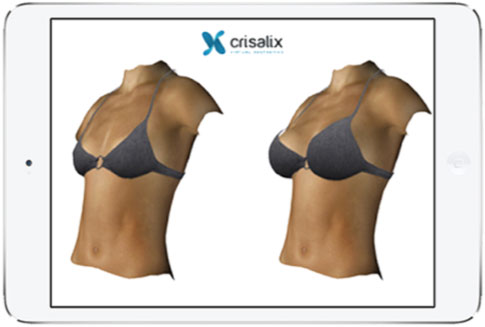 Learn More
Learn More